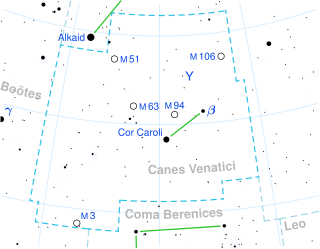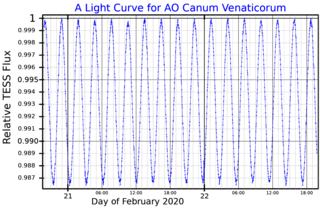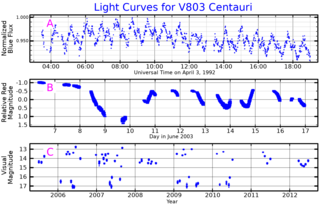
2M1207, 2M1207A or 2MASS J12073346–3932539 is a brown dwarf located in the constellation Centaurus; a companion object, 2M1207b, may be the first extrasolar planetary-mass companion to be directly imaged, and is the first discovered orbiting a brown dwarf.

Beta Canum Venaticorum, also named Chara, is a G-type main-sequence star in the northern constellation of Canes Venatici. At an apparent visual magnitude of 4.25, it is the second-brightest star in the constellation. Based upon an annual parallax shift of 118 mas, this star is 27.6 light-years distant from the Sun.

La Superba is a strikingly red giant star in the constellation Canes Venatici. It is a carbon star and semiregular variable.
24 Canum Venaticorum is a single star in the northern constellation of Canes Venatici, located 277 light years away from the Sun. This object is visible to the naked eye as a faint white-hued star with an apparent visual magnitude of +4.68. It is moving closer to the Earth with a heliocentric radial velocity of −18 km/s.

20 Canum Venaticorum is a single variable star in the northern constellation of Canes Venatici, located 238 light years from the Sun. This object has the variable star designation AO Canum Venaticorum; 20 Canum Venaticorum is the Flamsteed designation. It is visible to the naked eye as a faint, white-hued star with a baseline apparent visual magnitude of +4.72. The star is moving further from the Earth with a heliocentric radial velocity of +9 km/s. Eggen (1971) listed this star as a member of the Hyades Stream.
21 Canum Venaticorum is a single variable star in the northern constellation of Canes Venatici, located 277 light years away from the Sun. This object has the variable star designation BK Canum Venaticorum; 21 Canum Venaticorum is the Flamsteed designation. It is visible to the naked eye as a faint white-hued star with a baseline apparent visual magnitude of +5.14.
An AM Canum Venaticorum star, is a rare type of cataclysmic variable star named after their type star, AM Canum Venaticorum. In these hot blue binary variables, a white dwarf accretes hydrogen-poor matter from a compact companion star.

IQ Aurigae is a single, variable star in the northern constellation of Auriga. It is visible to the naked eye as a dim, white-hued star with an apparent visual magnitude that fluctuates around 5.38. The star is located at a distance of about 460 light-years from the Sun based on parallax and is drifting further away with a radial velocity of +28.6 km/s.

Gliese 268 is a RS Canum Venaticorum variable star in the Auriga constellation. RS CVn variables are binary star systems with a strong magnetic field influenced by each star's rotation, which is accelerated by the tidal effects of the other star in the system. Gliese 268 in particular is composed of a binary system of two M-type dwarfs, or red dwarfs, and is one of the one hundred closest star systems to the Earth. The primary component of the system has an apparent magnitude of 12.05, and the secondary component an apparent magnitude of 12.45. Neither is visible to the naked eye from Earth.

V803 Centauri is a cataclysmic binary consisting of a dwarf helium star losing mass to a white dwarf. It is an example of the AM Canum Venaticorum type of cataclysmic variable stars.

50 Persei is a star in the constellation Perseus. Its apparent magnitude is 5.52, which is bright enough to be seen with the naked eye. Located around 21.00 parsecs (68.5 ly) distant, it is a White main-sequence star of spectral type F7V, a star that is currently fusing its core hydrogen. In 1998 the star was named a candidate Gamma Doradus variable with a period of 3.05 days, which would means it displays variations in luminosity due to non-radial pulsations in the photosphere. Subsequently, it was classified as a RS Canum Venaticorum and BY Draconis variable by an automated program.
10 Canum Venaticorum is the Flamsteed designation for an ordinary star in the northern constellation of Canes Venatici. It has an apparent visual magnitude of 5.95, which, according to the Bortle scale, can be faintly seen with the naked eye from suburban locations. Based upon an annual parallax shift of 0.057 arcseconds, this system is 57.26 light-years from Sun. It is drifting further away with a radial velocity of +80 km/s.

Nu Horologii, Latinized from ν Horologii, is the Bayer designation for a single star in the southern constellation of Horologium. It was catalogued by the Dutch explorer Frederick de Houtman in 1603. With an apparent visual magnitude of 5.3, this star can be seen with the naked eye from the southern hemisphere. Based upon parallax, Nu Horologii lies at a distance of 169 light-years from Earth. It is drifting closer to the Sun with a radial velocity of +31 km/s.

In astronomy, a superhump is a periodic brightness variation in a cataclysmic variable star system, with a period within a few percent of the orbital period of the system.

SU Ursae Majoris, or SU UMa, is a close binary star in the northern circumpolar constellation of Ursa Major. It is a periodic cataclysmic variable that varies in magnitude from a peak of 10.8 down to a base of 14.96. The distance to this system, as determined from its annual parallax shift of 4.53 mas, is 719 light-years. It is moving further from the Earth with a heliocentric radial velocity of +27 km/s.

RS Canum Venaticorum is a binary star system in the northern constellation of Canes Venatici. It serves as the prototype to the class of RS Canum Venaticorum variables. The peak apparent visual magnitude of this system is below the level needed to observe it with the naked eye. It is located at a distance of approximately 443 light years from the Sun based on parallax, but is drifting closer with a net radial velocity of −14 km/s. Olin J. Eggen (1991) included this system as a member of the IC 2391 supercluster, but it was later excluded.

GP Comae Berenices, abbreviated to GP Com and also known as G 61-29, is a star system composed of a white dwarf orbited by a planetary mass object, likely the highly eroded core of another white dwarf star. The white dwarf is slowly accreting material from its satellite at a rate of (3.5±0.5)×10−11 M☉/year and was proven to be a low-activity AM CVn star. The star system is showing signs of a high abundance of ionized nitrogen from the accretion disk around the primary.

DM Ursae Majoris is a binary star system in the northern circumpolar constellation of Ursa Major, abbreviated DM UMa. It is sometimes identified by the Bonner Durchmusterung catalogue designation BD +61 1211; DM UMa is the variable star designation. The system has a combined apparent visual magnitude of 9.29, which is too faint to be visible to the naked eye. Based on parallax measurements, the system is located at a distance of approximately 606 light years from the Sun, but it is drifting closer with a heliocentric radial velocity of −7 km/s.

CR Boötis is an interacting binary system in the northern constellation of Boötes, abbreviated CR Boo. It is one of the best-known AM Canum Venaticorum stars. The system varies widely in brightness, ranging in apparent visual magnitude from 13.6 down to 17.5. The distance to this system is approximately 1,150 light years from the Sun, based on parallax measurements.

YZ Leonis Minoris, also known as SDSS J0926+3624, is a star system in the constellation Leo Minor. It is an AM Canum Venaticorum-type variable star, a type of binary systems with ultra-short periods. It is also an eclipsing binary. The apparent magnitude of the system is generally 19.3m, varying by about two magnitudes due to periodic eclipses and outbursts. The distance to YZ LMi is of 815 pc (2,660 ly).















